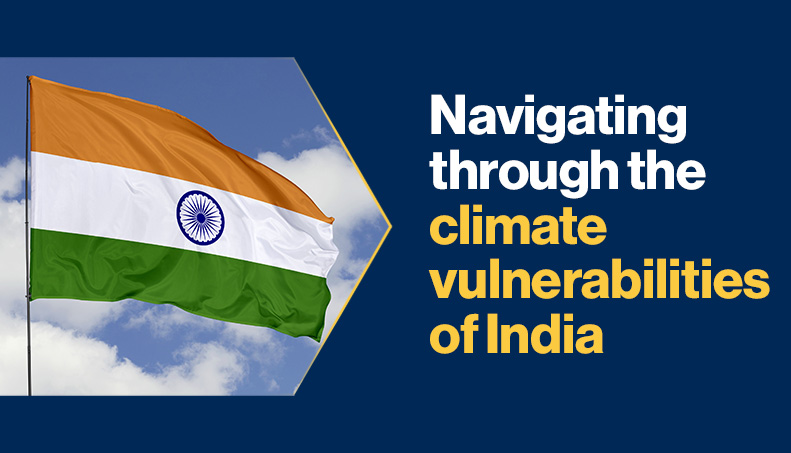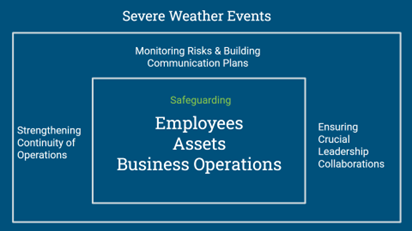Navigating through the climate vulnerabilities of India

India has its workforce distributed across the agriculture, industrial, and services sectors and it is also emerging as a global centre for technology. However, the country is susceptible to a variety of climate risks and is vulnerable to experiencing adverse impacts to a greater extent due to its diverse geography. Organizations are not immune to climate change, irrespective of their industries.
Several parts of Northern India have recently experienced intense cold waves and dense fog earlier than usual and, on the contrary, prolonged heat waves persisting into June. Bengaluru, known for its abundant natural resources, experienced water scarcity in March 2024 but around 80% of the country then experienced heavy rainfall that resulted in floods and landslides. Adverse weather conditions result in physical exhaustion and impacts on human health, damage to infrastructure, and disruption to transportation and logistics. In July 2024, Kerala’s Wayanad district was impacted by a series of landslides resulting in significant loss of life and damage to infrastructure.
Recent trends on severe weather events are evidence enough for organizations to prioritise preparedness to these calamities and to consistently adapt to the evolving threats surrounding the country’s dynamic risk landscape. Business continuity and resilience practitioners own a broader responsibility in being advocates of the discipline, while proactively considering potential impacts to their company’s people, assets and business operations. This article highlights three focus areas where practitioners can harness effective internal collaborations and leverage technology to navigate through bottlenecks when improving their organization’s ability to act swiftly before, during and after an extreme weather situation.

Monitoring risks & building communication plans
80% of people in India live in districts that are frequently impacted by extreme weather events. India is the seventh most likely country to be subjected to climate extremes, as highlighted by the Council on Energy, Environment and Water (CEEW). The 2024 remote work statistics and trends data published by Forbes, also reports around 40.9% of the workforce are either in remote or hybrid working conditions.
While organizations are becoming more flexible to remote and hybrid work culture, it is essential to have real-time monitoring of weather conditions across the region. An established command centre plays a pivotal role in monitoring threats and geo-tracking of the employees using digital tools as need arises. To determine a unified course of action, business continuity practitioners must enhance connections between the organization's command center and other departments that might possibly be impacted due to a severe weather event.
India is a culturally diverse country, and this is often reflected in the ways companies build relationships with their staff and customers. Mass notification systems must be integrated with the organization’s familiar communication channels, with access to credible data such as employee contact details. The National Disaster Management Authority (NDMA) conducted a crucial test through the cell broadcasting system for the nation’s new emergency alert system in September 2023, and similar tests must be performed to assess an organization’s readiness to deliver timely alerts in case of genuine emergencies.
Top management holds great responsibility in cascading time-sensitive information to employees during adverse situations through robust communication plans. Extreme weather situations can disrupt network availability, and emergency mass notification systems provide multiple mediums to alert staff with critical information that will help them respond better to adverse situations. These systems must be used to send messages swiftly to the impacted employees, while also helping track of their responses.
Ensuring crucial leadership collaborations
Adverse weather conditions are expected to have a significant impact on both employees and organizations. Collaboration between stakeholders is key to helping an organization overcome complex operational challenges. Practitioners are required to have proactive measures to identify key leaders from different departments and provide them with adequate training sessions to have coordinated responses as per the organization’s size and maturity. Delivering scenario-based exercises with the identified group of key departments is an effective way to help teams locate gaps in the current response processes before a real-time impact situation.
Lack of defined leadership responsibilities within organizations hinders their ability to respond quickly during adversities. Extreme weather events can bring in a multitude of challenges and not having a coherent process will further worsen the situation through negative outcomes caused by misinformation, duplication of efforts, siloed approaches between teams, and lack of accountability. Leadership contribution is extremely critical when emergencies occur. It is vital to have heightened awareness amidst key stakeholders. business continuity practitioners can influence cross collaboration within departments and join their forces by being trusted advisors in coordinating risk-informed decisions.
Strengthening continuity of operations
Adopting a robust business continuity framework is no longer a luxury, but an essential part of an organization during a major interruption. It is important for business continuity practitioners to track critical functions that might have exposure to threats of extreme weather events. This can be achieved through a risk register maintained with insights from business impact analysis (BIA) sessions that cover areas such as single points of failures associated with staff, location, and infrastructure dependencies.
Resilience professionals have a holistic view of the organization’s interdependent teams. Even when functions have their standalone response plans, collaboration between these standalone functions is crucial to achieve an organization’s resilience objectives. Resilience is achieved when the critical core teams collaborate to provide a unified response to disruptive situations. business continuity practitioners must assign programme champions in these teams, who will be activated through common communication platforms to rally the necessary support during emergencies. An example of this is a successfully coordinated response between teams that include real estate or operations teams to advise on the availability of infrastructure, procurement teams to ensure supplier recovery capabilities, security teams to enable safety of people, and legal teams that fulfill the statutory obligations.
Depending on the scale and complexity of the departments in the organization, business continuity practitioners must stay ahead of the curve by identifying climate risks that will prospectively impact the existing functions covered in their business continuity plans (BCPs). When enabling relationships between the core teams, resilience professionals play a significant role in elevating effective coordination between interdependent departments to deliver consistent responses to extreme weather situations.
The way forward
India is now expected to experience adverse weather events almost every day in the first few months of the year according to the independent think tank Centre for Science and Environment (CSE).
By being prepared for climate risks, organizations can also be better equipped to manage other areas of threat to business operations. business continuity practitioners must ensure that efforts are invested to find the right approach, aligning to the organization's priorities, that are agile and adaptable as the effects of climate change are experienced.
References
Delhi shatters 74-year records with the hottest May and June on record | India News - Business Standard (business-standard.com)
Analysis: Indian tech hub Bengaluru reeling from water crisis (asiapacific.ca)
The 30 July 2024 Wayanad landslides in Kerala, India (eos.org)
Remote Work Statistics And Trends In 2024 – Forbes Advisor INDIA
What is India's Climate Change Vulnerability Index (CVI) ? CEEW
Climate Change Indicators: Weather and Climate | US EPA
NDMA tests pan-India 'emergency alert system' for disaster management | India News - Business Standard (business-standard.com)
India saw extreme weather events almost every day in first 9 months this year: Report - The Hindu































